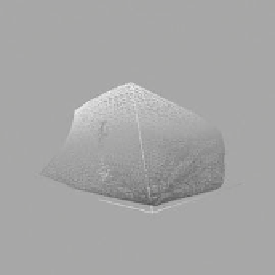Image Processing Reference
In-Depth Information
FIGURE 7.67 (See color insert following page 428.)
Example of in-gamut color
sweeps
—
susceptible to contours (see Figure 7.39 for performance with MM algorithm vs.
the control-based inversion).
reduced contours, balanced neutrals, improved highlights, improved image details
and can be an enabler for photo rendering if the halftone screens and printer
resolution is up to the desired quality. Emulation with respect to industry color
standards like GRACoL, ISO, Japan Color or other source color spaces becomes
easy provided the colorants have enough gamut coverage.
Often, the in-gamut colors are shifted deliberately to offset bias in the printing
system or to render more preferred outcome. For example, sky colors are generally
centered on a 280 degree hue angle and may be purposely detuned with a hue shift
for preference matching during the pro
le creation stage. Any intentionally induced
color shifts may not give a good match to the original, but has the effect to
render more preferred color. Nonsmooth color transitions can cause contours.
In Figure 7.39, grass contours occurred due to an inaccuracy in the pro
les created
by the MM algorithm. These colors are inside the printer gamut (see Figure 7.67).
Also, contouring can occur when color sweeps intersect the gamut boundary.
For example, when color sweeps occur from dark out-of gamut color to light
in-gamut color as in human arm (Figure 7.68) or sensitive regions, such as in
skin tones, we may see gamut-mapping issues like many-to-one mapping. Inaccur-
acies in the inversion process can also lead to nonideal behavior in gamut-mapped
colors as seen in Figure 7.38 and in the corner plots (roundtrip accuracy) shown
in Figure 7.65, which is largely due to unpredictability associated with near-
boundary colors.
Since GCR plays an important role in high quality color reproduction using
toner or inks, when the tone scales appear dirty or grainy or nonuniform with
black toner, then tone scale suppression may be required. In addition to this, if the
CMYK formulations are not smooth between nodes of the pro
le LUT, we can
expect to see contours. Hence the task of achieving smoothness without loosing
roundtrip accuracy is a real challenge to high quality reproduction with multidi-
mensional LUTs.




Search WWH ::

Custom Search